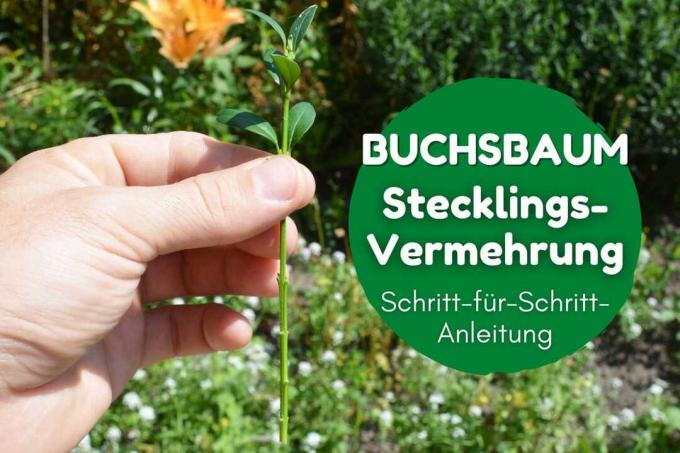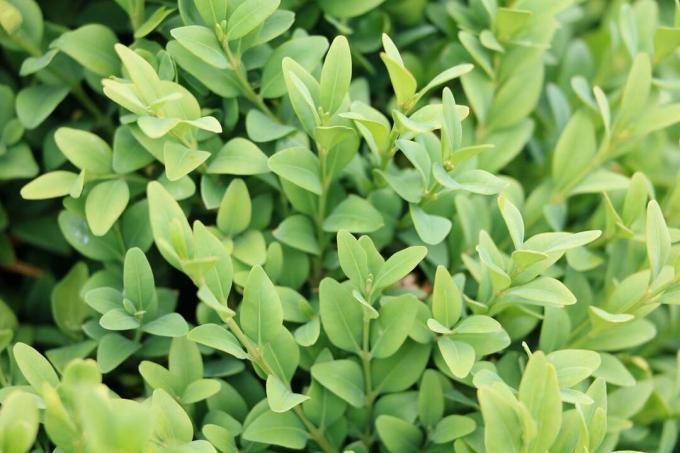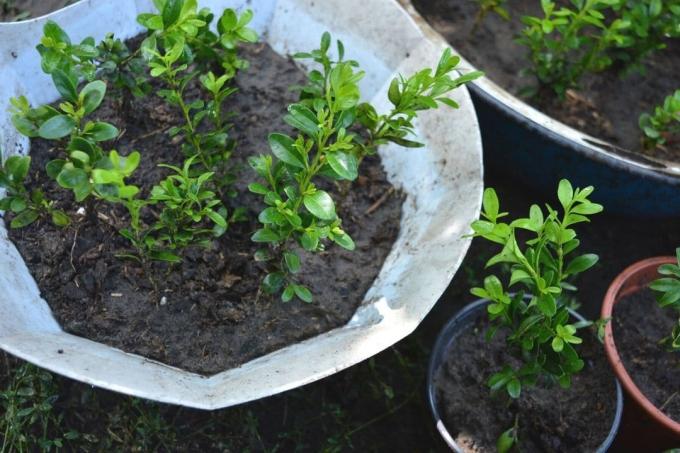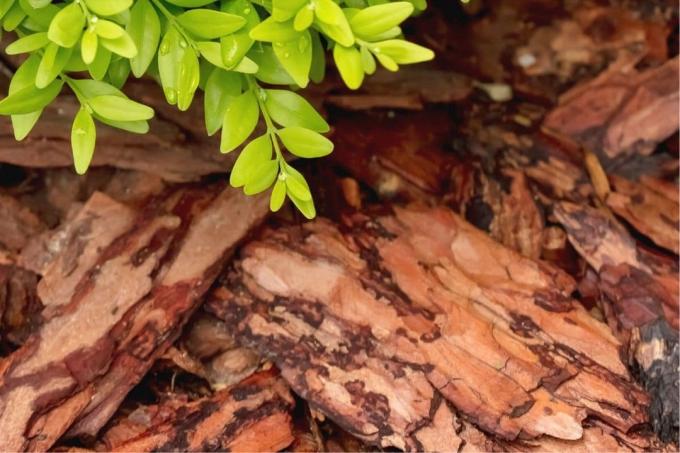
table of contents
- Best time
- Suitable boxwood
- Suitable cutting
- Instructions for propagating cuttings
- Cut and prepare
- Set
- to water
- Overwinter
- Follow-up care
- frequently asked Questions
The box tree (Buxus) can simply be multiplied by cuttings. Important details and step-by-step instructions for growing beds and pots can be found here.
In a nutshell
- Propagation by cuttings is most promising
- the right time is crucial
- lignified shoots reduce the risk of fungus
- then optimally care for the cuttings
Best time
Theoretically, a box tree can be propagated by cuttings during the entire gardening season / growing season. However, the best time has come in midsummer at the earliest. Ideally, late summer is chosen from the end of August to the beginning of September. Then amateur gardeners benefit from the following advantages:
- Lignification of new shoots started - reduces risk of Fungal infections
- sufficiently robust shoots to withstand high loads on roots and shoots
- Boxwood grows faster in mid / late summer - better for growing
- Protect the bed sufficiently from the first frost
Alternative in the pot
If the best time to propagate cuttings has been missed, box trees can be planted in a pot until October. The advantages remain, but in the event of approaching frost and increasingly colder nights, the cuttings move to frost-free winter quarters. This saves them the energy they need for rooting.
Suitable boxwood
A strong, healthy mother plant is required so that the cuttings of the boxwood grow well, form roots before the first frost and get through the winter months robustly. This is also a prerequisite for the mother plant to survive the loss of shoots and not be weakened.

A suitable Buxus fulfills the following criteria:
- dense growth
- rich leaf green
- grown tall
- at least two, better three years or older
- pest free
- healthy without previous or current illnesses
Suitable cutting
The ideal cutting looks like this:
- well developed
- about ten centimeters long
- slight brown discoloration of the bark
- not completely lignified; otherwise the formation of roots is difficult
Instructions for propagating cuttings
Cut and prepare

- Select and separate shoots with several side shoots (cuttings) that are at least two years old
- Tear off the side shoots on the "shoot trunk" so that astring with a divisible tissue remains
- Cut off the bark tongue on the crack (cutting) for a straight cut and better sticking
- Shorten the tips of the cracks by a third (prevents rapid drying out and promotes dense crown growth)
- Remove leaves from the lower third
- Place crackling two to three centimeters in a water container for between twelve and 24 hours
- Before setting, dip the interface in algae powder or special mineral rooting powder
Note: Immersion in rooting powder or algae flour is not absolutely necessary, but it clearly promotes growth.
Set
In the bed
- Soil: mix normal, well-drained, loose garden soil with sand
- Put the cuttings into the soil until the first leaves
- Plant spacing: small varieties up to 15 centimeters high, six to eight cuttings; four to six cuttings over 15 centimeters in height
- Location: sheltered from the wind; sunny to partially shaded; not hot
In the pot
- Use a pot with a water drainage hole
- Fill in potting soil or nutrient-poor substrate
- Insert the cuttings up to the first leaves
- for stability: press the soil lightly
- Pour generously
- Prick out: as soon as the first shoots / leaves can be seen
- After pricking out, plant in a nutrient-rich substrate

Tip: It is advisable to stretch a translucent, transparent film over the pots to maintain continuous moisture. This is to be opened every second day for the oxygen exchange and removed again after the formation of the first new shoots / leaves.
to water
Moderate soil moisture is required for root formation and establishment. "Pouring over" and waterlogging must be avoided at all costs because they provoke mold. The optimal casting time can be found out using a thumb test:
- The thumb can easily be pressed more than two centimeters into the surface of the earth: do not water
- The thumb can be pressed less than two centimeters into the surface of the earth: watering required
Overwinter
When wintering boxwood cuttings, a distinction must be made between bedding and pot planting.
In the bed
If the cuttings were planted in the garden bed in late summer, they will usually have grown into viable young plants at the beginning of frost / winter. An insulating layer on the surface of the earth protects them from freezing temperatures. Various materials are suitable for this, such as:
- straw
- leaves
- brushwood
- Pine needles
- Bark mulch
- Garden fleece

In the pot
The cold gets unfiltered through the walls of the pot and the bottom. If the substrate freezes through, the freshly grown and still sensitive roots can suffer life-threatening damage. For this reason, cuttings in pots should always be moved to frost-free winter quarters. This should meet the following requirements:
- Temperature: between two and five degrees Celsius
- Light: partial shade
- no wind or drafts
- ideal location examples: light cellar; unheated conservatory or greenhouse; Garage or garden shed with windows
Follow-up care
When the cuttings have come through the winter in good health, they experience their first spring as an independent, self-propagated plant. The following should be noted:
Bed cuttings
- Enrich the soil with ripe compost
- water regularly without overwatering
- first cut not before autumn
- Green manure only from the second year

Pot cuttings
- slowly get used to the field
- Plant in the garden bed at the earliest from mid-May after Eisheiligen
- Mix the garden bed with ripe compost beforehand
- Protect from direct and too much sunlight, otherwise risk of burns
- do not fertilize until the second year after planting
- Ensure uniform soil moisture
- can now spend winter in the garden bed
frequently asked Questions
If a cutting meets ideal conditions, it usually grows between ten and 15 centimeters per year. Large varieties can also grow at speeds of up to 20 centimeters per year.
In principle, boxwood should not be cut more than once every four weeks. Accelerated growth cannot be achieved if this “rule” is adhered to. However, nitrogen fertilizers can promote growth. But you shouldn't practice that, because fast growth always means a higher susceptibility to diseases and pests for a Buxus. In addition, it primarily weakens the young plants, which in the worst case may not survive the next winter without damage.
You should put protection against the cold at the latest when the weather forecast announces frost for the next few days. It is better to be on the safe side beforehand, because frost can also occur unexpectedly. Until mid-October is a recommended time.

